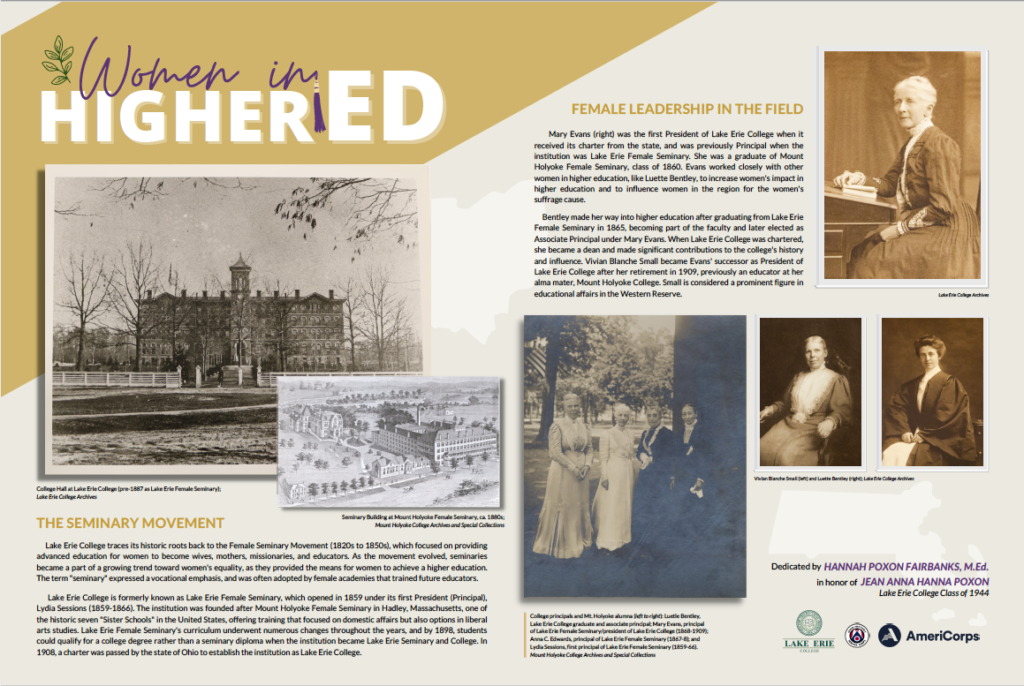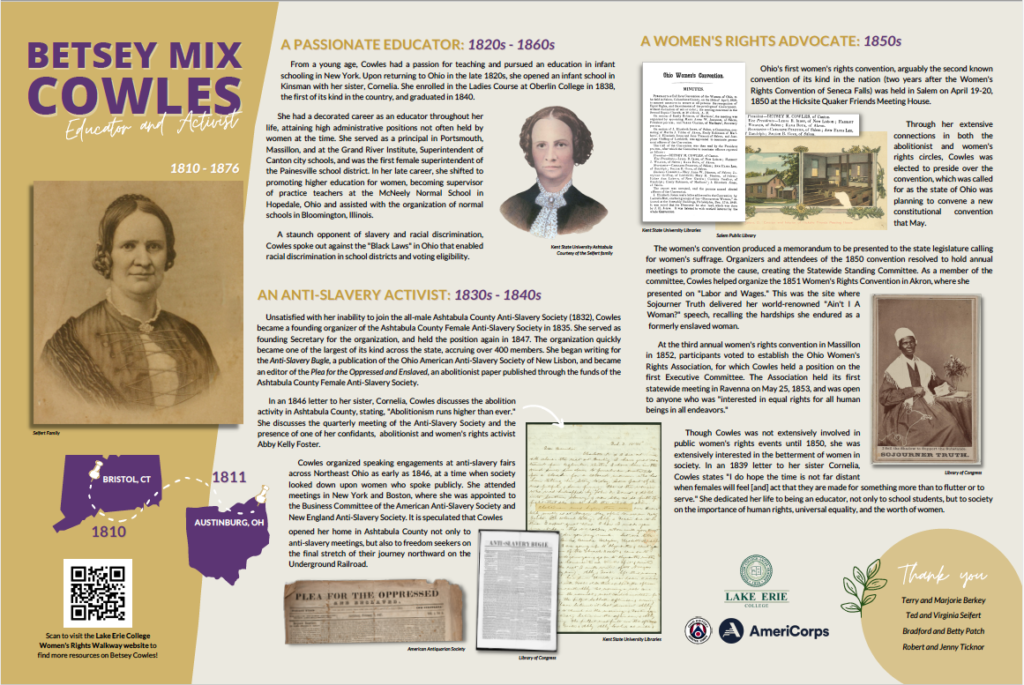Course: CM270 Rhetoric of Women’s Rights
Department: School of Arts, Humanities and Social Sciences
Institution: Lake Erie College
Instructor: Dr. Katharine Delavan
Number and Level of Students Enrolled: 10 students, Freshman-Seniors
Digital Tools/Technologies Used: Ohio Memory Library of Congress She Resisted Interactive
Author Bio: Katharine Delavan is the Dean of the School of Education at Lake Erie College. She has conducted historical research of Painesville, Ohio, since 2009 when she began studying local abolitionist and Underground Railroad history. During this research she learned Painesville and Lake Erie College had a proud suffrage history to share.
During the Spring 2020 and Spring 2021 semesters, I taught a special topics course entitled CM270 Rhetoric of Women’s Rights. The Spring 2020 semester was co-taught by Dr. Nicole Kathol and myself. Dr. Kathol has vast expertise in public speaking and women’s rights. My expertise focused on the local history of the suffrage movement. Together we created an experiential academic course that merged the study of rhetorical practices and strategy with historical research. During the Spring 2021 semester, I taught the course independently and continued the combined approach to study the strategies and rhetoric of the women’s rights movement and the historical significance of local and regional citizens who positively impacted the movement. The experiences and outcomes of this course surpass the limits of this case study. I am focusing on the key approaches to analyzing suffrage speeches and the motivations of the movement’s activists.
The Spring 2020 course was embedded in our Centennial Celebration of the Passage of the 19th amendment and was implemented with the intent of students, and faculty, conducting research to establish Lake Erie College alumnae as relevant to the women’s suffrage movement. We did accomplish this goal, and then some. The research that resulted from the 2020 course led to the creation of the centennial celebration webpage, earning a place on the National Votes for Women Trail and most importantly current students sharing the stories of alumnae’s activism. Sadly, these stories had been forgotten, but we have now reclaimed our history and proudly share them to inspire others and show that this history is relevant today. On August 26th, 2021 we are dedicating the Women’s Rights Walkway on campus in front of the college hall to honor the Lake Erie alumnae and to keep their stories alive for generations to come. The walkway will house the Pomeroy Historical Marker dedicated to Mary Evans, 5 interpretive signs that provide additional information about the Painesville ERA, the 1885 OWSA Convention, Women, and Higher Education, History of the Suffrage Movement, and Betsey Mix Cowles. The intent is to dedicate new signs every year until all of our alumnae and local citizens are represented.
Analysis of Rhetorical Methods
Following an analysis of the cult of true womanhood (Welter, 1966) and an explanation of the promiscuous audience (Zaeske, 1995), the fact that women were not allowed to speak publicly if men were in the audience shocked students. Students examined the role of women in public speaking arenas by looking at the authors/speakers’ call to action, call for disruption of norms, and the contextual barriers that were in place at the time. They also considered the narrative or story that was told, the use of aesthetic language, and the credibility of the author/speaker. In whole group and small group discussions, students analyzed speeches and writings by Frederic Douglass, Elizabeth Cady Stanton, Frances Jennings Casement, Sojourner Truth, and Lucy Stone among others. We also examined the anti-suffrage rhetoric, but the outcomes of those discussions and research are worthy of another article.
Each class session resulted in deep discussion and analysis of the views of women in the past and today. We consistently connected the past with the present, identifying haunting parallels with current events. Students immediately noticed the rhetoric of anti-suffrage for women and African-American men was eerily similar to the rhetoric of those opposing the Black Lives Matter movement. Students also acknowledged that they had very little knowledge of the women’s suffrage movement before taking this class. Many times they asked, “why did we not learn about this before” and “why is this a ‘special class,’ everyone needs to know this history.”
Research with Primary Documents
Students chose a historical event or figure relevant to the women’s suffrage movement to research and present to the class. They were introduced to a variety of online databases that house suffrage documents. Our primary source was Ohio Memory which was used to look at Frances Jennings Casement documents, especially the Painesville ERA Diary which she kept from 1883-1885. We also accessed the Library of Congress Women’s Suffrage Digital Collection. Students also examined the timeline and components of the suffrage movement through online interactive sites including She Resisted Interactive.
Because the intent of the course was to raise awareness of the Lake Erie College (aka Lake Erie Female Seminary) alumnae involvement and impact on the suffrage movement, we focused on the Painesville ERA (1883-1885) and its evolution into the Ohio Women’s Suffrage Association and finally the League of Women Voters. Frances Jennings Casement was the driving force behind the Painesville ERA. She organized Parlor Talks at homes throughout the city of Painesville to recruit members, sign petitions to get suffrage on the ballot in Ohio. She smartly brought her influential husband, Gen. Jack Casement with her to most meetings, because she wanted to recruit men into the movement, as they were ultimately going to vote to grant women suffrage, or not. Thankfully, Frances kept a diary of most of the Painesville ERA’s meetings and the Ohio Historical Society has provided digital access to the diary, and even transcribed each page. This primary source is an invaluable resource for our work.

A secondary source that provided a wealth of information and spurred a wealth of research projects is the 1885 Ohio Woman’s Suffrage Association Convention (OWSA) proceedings as published in the New Era June 1885. This document tells us who spoke at the convention, how many attended, the resolutions that were passed, and the sentiments shared by some of the delegates and guest speakers. The 1885 OWSA Convention was held on May 12th-13th at the Painesville at the Methodist Church, due to the hard work of OWSA President Frances Jennings Casement. The guest speakers were Susan B. Anthony, Helen Gougar, and Rev. Olympia Brown among other state chapter delegates. Even more important to the history of the Lake Erie Female Seminary (aka Lake Erie College) was the fact that Principal Mary Evans (soon to be the first President of the college) spoke briefly at the convention and brought students to the convention.

This occurrence did earn the college a Pomeroy Historical Marker, literally putting the college on the map of The National Votes for Women Trail. Following the convention Susan B. Anthony did visit the seminary where she met with students and faculty. This is documented in a letter she sent to Mary Evans on May 21, 1885, thanking her for the chance to speak to the “Heads and Hearts” of the girls. We also read letters between Frances Jennings Casement and Mary Evans planning the visit of Susan B. Anthony.

Experiential Learning
During the 2020 semester, just before the COVID shutdown, we traveled to Seneca Falls and toured the Women’s Rights National Park, The Elizabeth Cady Stanton House, The Susan B. Anthony House and the gravesites of Susan B. Anthony and Frederick Douglass. We also took a tour of Route 45 sites in Jefferson, Ohio including Betsey Mix Cowles House, Jefferson Congregationalist Church, Joshua Gibbings Law Office and the Harriet Taylor Upton House, and the Free Speech Chapel in Newbury. We also visited the Casement House, currently owned by Sidley Construction.
During the Spring 2021 semester, our travel was limited so we participated in a virtual tour of the Susan B. Anthony House and took a field trip to the Painesville Methodist Church where the 1885 OWSA Convention was held.
It is important to note that this course was taught through a collaborative learning approach. I did not lecture to students. I presented brief background information, provided necessary documents, and then students worked in groups or partners to research using historical thinking methods. Then students presented their findings to the class, so they owned their learning and were invested in the outcomes. This approach also led to deeper discussion because the students felt welcome to share and ask questions.
The lessons learned from the two Rhetoric of Women’s Rights courses taught in 2020 and 2021 are very clear and specific. First, most people do not know about the women’s suffrage movement. So we have a responsibility to change that in our schools and in our communities. Second, experiential learning is the best approach for teaching history. It allows students to interact with the past, meet historical figures through historical interpretation, and visit actual sites where history happened. Ohio is truly one of the top states for studying the history of the suffrage movement, several key events took place in Cleveland and across the state of Ohio that more people need to know about as it impacts our lives today in relation to voting rights and women’s rights.
References
New Era Newspaper, June 1885, Vol 7, No. 6.
Welter, B. (1966). The Cult of True Womanhood. American Quarterly, Vol 18, No. 2, part 1, pgs. 151-174. http://links.jstor.org/sici?sici=0003-0678%28196622%2918%3A2%3C151%3ATCOTW1%3E2.0.CO%3B2-H
Zaeske, S. (1995). The Promiscuous Audience Controversy and the Emergence of the Early Woman’s Rights Movement. Quarterly Journal of Speech, Vol 81, pgs. 171-207.
Dedicated Sign Examples




